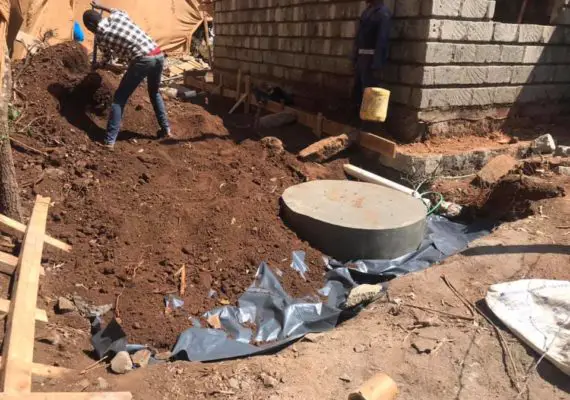Septic Tank Design Details | Septic Tank Design 3 Chambers | How to Build a Septic Tank Concrete
Septic Tank Design |Septic Tank Construction Drawings |Types of Septic Tank Designs | Advantages and Disadvantages of Septic Tank
Definition of Septic Tank
Septic Tank is a water-tight receptacle that receives the discharge of human waste from the toilets. It is an underground storage chamber made of concrete, fiberglass, or plastic and is intends to control, manage, and most importantly treat waste material. It also has some partial decomposition is based on anaerobic bacterial reaction solids and organics materials reduce to liquid.
It’s basically a type of biodigester, only that it lacks the functionality of gas collection and waste treatment. Most septic tanks just separate the solid and liquid waste material. The wastewater will collect at the slung heap up at the bottom. As a result, the tanks will require emptying from time to time.
Septic Tank Design 2-3 Chambers
It is best to construct a single compartment for small capacity septic tanks. Larger capacities are the best fit for a two-compartment tank. The wall separating the two is about two-thirds the length away from the inlet. It, therefore, perform better than the single compartment tank. The two compartments interconnect above the sludge storage using pipes or square openings.
A concrete or plastic tank is the best to use. The floor and side walls are made using concrete and plastered to render a smooth surface. The floor has a slight slope of 10 percent towards the sludge outlet. As a result, slung moves out more easily
It has one end connected to an inlet from the toilets and sometimes an outlet connected to the drain field. Some septic tank design has 2 chambers while others have 3 chambers. A wall with openings between the floor and roof of the tank separates the chambers. As a result, the drainage pipes fill more evenly and preventing premature clogging of the drains, therefore, extending their life.
Some septic tank designs include water pumps so as to increase the volume and velocity of water drainage.
💥🎁 Christmas & Year-End Deals On Amazon !
Don't miss out on the best discounts and top-rated products available right now!
🛒 Shop Now and Save Big Today!*As an Amazon Associate, I earn from qualifying purchases.
Septic Tank Construction Drawings

A well-maintained septic system is odor-free and requires less emptying.
In addition, it should last for decades with no problems.
How a Septic Tank Works
A septic tank works in four basic steps. Namely :
- Receives the wastewater from the house- all the house wastewater goes to the septic tank through one inlet.
- Separates the solids from the liquids- The solid waste settles at the bottom of the tank. The wall separating the chambers allows for liquid only to move to the second chamber. The solids materials remain for degrading.
- Decomposes the solids– Bacteria is used to decompose the solid waste into liquid. The bacteria feed on solid waste and free it from pathogens. They further reduce them to water.
- Send the wastewater out to the drain field- the treated waste is released to the ground or left to percolate into the soil. Some tanks may include a pump to assist in pushing water out of the septic system.
Factors to Consider When Designing a Septic Tank
Septic Tank Capacity/Size
The septic tank capacity depends on the sewage flow and detention period. In addition, space for sludge and scum accumulation before emptying is also considered. Depending on the type of house and the number of the user, septic capacity can be customized. The table below shows capacity Viz a Vis number of users.

💥🎁 Christmas & Year-End Deals On Amazon !
Don't miss out on the best discounts and top-rated products available right now!
🛒 Shop Now and Save Big Today!*As an Amazon Associate, I earn from qualifying purchases.
Amount of Sewage Flow
The amount of sewage flow highly depends on the number of users. The tank should be able to hold the total waste for all users during the detention period.
If the design does not account for all users, the tank will block more often and require emptying more frequently. This, on the other hand, increases the cost of maintenance.
Sludge Holding Period
The septic tank design should account for the sludge holding period. The minimum sewage detention period in a septic tank is 24 hours. However, due to the total volume requirement for sludge and scum accumulation, a septic tank is designed for a detention period of not less than 48 hours.
Septic Tank Construction
A septic tank construction should be perfect to prevent cracking and groundwater pollution. In addition, it should be strong enough to withstand the Earth’s movements and hold the weight of the waste. Most importantly, it is best to use plastic or reinforced concrete tanks.
Septic Tank Design 3 Chambers: How to Build a Septic Tank Concrete
Concrete Septic Tank
💥🎁 Christmas & Year-End Deals On Amazon !
Don't miss out on the best discounts and top-rated products available right now!
🛒 Shop Now and Save Big Today!*As an Amazon Associate, I earn from qualifying purchases.
A trench is dug and steel is placed where concrete is moulded on both sides to form a 4 inches thick wall. This provides the strength for the tank to hold pressure and also prevents the steel from rusting. The inlet and outlet pipe are put in place before pouring the concrete. It is very important you mix the concrete is well.
Add little water to harden the concrete. Use a vibrator to ascertain that it has compacted properly with no air holes or cracks. After that, connect the pipe to the inlet and outlet and also install the manhole slab.
How A Typical Conventional Septic System Works:
All water runs out of your house from one main drainage pipe into a septic tank.
The septic tank is a watertight container that is usually buried and composed of concrete, fiberglass, or polyethylene.
The job of septic tank is to hold the wastewater long enough for solids to settle to the bottom and form sludge, while oil and grease float to the surface and form scum.
Compartments and a T-shaped outlet keep sludge and scum from exiting the tank and entering the drainfield.
💥🎁 Christmas & Year-End Deals On Amazon !
Don't miss out on the best discounts and top-rated products available right now!
🛒 Shop Now and Save Big Today!*As an Amazon Associate, I earn from qualifying purchases.
After that, the liquid wastewater (effluent) exits the tank and flows into the drainfield.
The drainfield is a shallow, covered hole dug in unsuitable soil. Pretreated wastewater is discharged by pipelines onto porous surfaces, allowing the wastewater to filter through the soil. As it percolates through the soil, wastewater is accepted, treated, and dispersed, eventually discharging to groundwater.
If the drainfield becomes overburdened with liquid, it might flood, causing sewage to spill to the ground surface or cause backups in toilets and sinks.
Finally, wastewater percolates into the soil, removing dangerous pathogenic organisms, viruses, and nutrients naturally. Bacterial pathogens are bacteria that live primarily in the intestines of humans and other warm-blooded animals. It’s a sign of human fecal contamination.
Sludge Withdrawal and Disposal

💥🎁 Christmas & Year-End Deals On Amazon !
Don't miss out on the best discounts and top-rated products available right now!
🛒 Shop Now and Save Big Today!*As an Amazon Associate, I earn from qualifying purchases.
Emptying a septic tank happens once or twice a year. Individual home tanks can lust for 2 years. Note that disinfection agents like phenyl can kill the bacteria in the tank.
As a result, do not use flush chemicals down the toilet. In addition, non-biodegradable waste material like condoms and sanitary pads cannot decompose when inside the tank. As a result, do not throw them into the toilet because they may lead to blocking or fill the tank sooner.
Septic Tank Maintenance
Similar to any other system, a septic tank may become faulty and requires maintenance.
Septic tanks should be pumped out every five years to keep the disposal system working properly. However, this may need to be done more often, for example, if they overflow or become blocked. The septic tank effluent should be well and carefully disposed of away so as to prevent any nuisance or danger to public health. This is because it has a foul smell and contains a substantial portion of dissolved organic matter and pathogenic organisms.
While making waste disposal, an exhauster truck fetches the wastewater from the septic tank using hydraulic power. The track then carries it to land set aside for disposing and treating of the wastewater.
The top cover of a septic tank is watertight and very thick. However, a manhole of relative size is created. This allows inspection and emptying of the tanks.
💥🎁 Christmas & Year-End Deals On Amazon !
Don't miss out on the best discounts and top-rated products available right now!
🛒 Shop Now and Save Big Today!*As an Amazon Associate, I earn from qualifying purchases.
Septic Tank Failure
The main causes for a septic tank failure include:
- Too much disposal of grease and cooking oils may cause the drains to block. This is because they are difficult to decompose. It can also result in an odour.
- Non-biodegradable waste will cause the septic tank to fill up and clog. Do not flush these materials down the toilet.
- Some chemicals can damage the septic tank components. This includes inorganic material like paint and solvents, water softener, pesticides among others.
- Tree roots protruding may plunge and clog the pipes or even worse rupture the septic tank. The trees tend to grow rapidly as a result of continuous nutrients supply from the septic system.
Other things that can make a septic tank to fail include a high water table, biofilms that develop over time, and covering the system with an impermeable surface
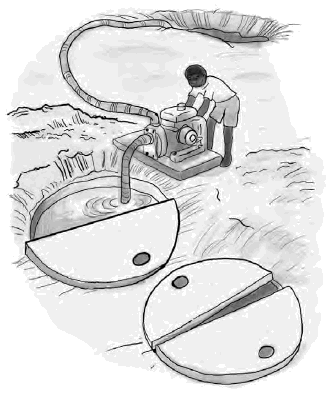
A septic tank design has to be well really thought out so that it will never crack and pollute the groundwater. In addition, they should be able to hold the weight of the wastewater. In addition, it is odorless, more importantly; it should be able to stand any kind of earth movement. A septic tank design should be good and accurate. As a result, it can last up to 50 years of course with good use and maintenance.
Problem Signs In Septic Tanks
The septic tank will need to be checked if there are signs that it is not working properly.
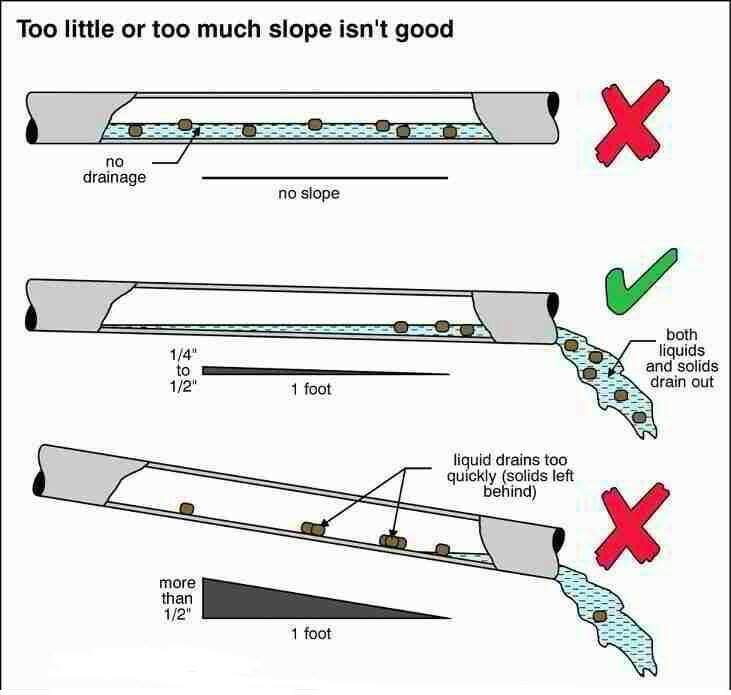
💥🎁 Christmas & Year-End Deals On Amazon !
Don't miss out on the best discounts and top-rated products available right now!
🛒 Shop Now and Save Big Today!*As an Amazon Associate, I earn from qualifying purchases.
Some signs that a septic tank is not working properly are:
- The sewage in the toilet or the liquid waste from other fixtures flows away very slowly
- Liquid waste overflows from the disconnector trap
- Wet areas are seen at the top of the septic tank
- There is a strong unpleasant smell near the septic tank
- The grass around the tank is very green and growing well
Advantages and Disadvantages of Septic Tank Systems
Advantages of Septic Tank Systems
1. Economical
Having a septic system can save you a lot of money. It is a more cost-effective way of plumbing, instead of installing new pipes and wasting water. Your septic tank will all but eliminate your public water bills, which will reduce your plumbing costs in the long run.
2. Easy to install
A septic tank is easy to install, especially with a DIY kit that you can buy from a hardware store. A lot of companies also provide septic tank installation services, which will save you the trouble of doing it yourself.
3. Can last for years
Most Septic Tank systems are designed to last for many years, so you don’t have to worry about them falling apart quickly. Septic Tank systems function very well when properly maintained and checked by a professional plumber on a regular basis.
3. More than just a wastewater disposal system
Septic tanks are more than just wastewater treatment systems. It is a sewage collection and storage system. The waste in septic tanks can be redirected to other areas, making it an ideal spot to dispose of the waste before returning it to the ground.
4. Very clean
Separating human wastes from other types of organic garbage will require that you have a septic tank whether you want it or not. Some people choose to install a septic system even if they have another sewage treatment system.
💥🎁 Christmas & Year-End Deals On Amazon !
Don't miss out on the best discounts and top-rated products available right now!
🛒 Shop Now and Save Big Today!*As an Amazon Associate, I earn from qualifying purchases.
5. One of the best ways to recycle
Wastewater recycling is one of the best ways to save natural resources. This is beneficial for both the environment and for your bottom line. Septic tanks are an essential part of wastewater recycling.
6. Lower maintenance
The maintenance cost of a septic tank pertains to a property owner’s or tenant’s bill, not to the general public. The difference is usually calculated as a percentage based on the size of the property. It also depends on how many facilities are connected to the system.
So if you have more buildings connected to the septic system, then you will have to pay more for their maintenance and upkeep in general.
Septic tanks are very easy to maintain, especially compared to other types of systems. It needs little maintenance and replacements on a regular basis.
Most septic tanks can last for decades if they are properly maintained. So in the long run, you will save money in the form of repairs and services that you wouldn’t have to perform on your basement or other plumbing system.
💥🎁 Christmas & Year-End Deals On Amazon !
Don't miss out on the best discounts and top-rated products available right now!
🛒 Shop Now and Save Big Today!*As an Amazon Associate, I earn from qualifying purchases.
Disadvantages of a Septic Tank System
1. Expensive
Most septic systems are more expensive than a regular sewage treatment system. It is because a septic tank can dispose of much more than wastewater. The cost of septic tank installation and maintenance varies depending on the type of system you choose to install.
2. Issues with bacteria
As it was mentioned earlier, Septic Tank systems are supposed to dispose of human waste in order to prevent other people and animals from being exposed to pathogens and bacteria, which can cause other health problems. This is why bacteria is very important for a septic tank to function properly.
3. Waste slows down the drain
Wastewater will not go through the septic tank as fast as it went through the sewer pipes. It gets filtered and concentrated in the septic tank, which can increase its size or cause other problems.
4. Gets clogged easily
Septic tanks aren’t as easy to clean as regular sewage systems. The waste material can get lodged in the pipes or fittings of an obsolete septic system. Clogging can cause insufficient drainage and waste to overflow.
5. Unsanitary
Even with disinfectants, you will still need to be careful when disposing of waste and taking a shower in your septic tank. You can always opt for an alternative but it is best to get a new septic system that’s sanitary and safe for your family members.
6. Not as convenient
Septic tanks are not as convenient as new, state of the art sewage treatment systems. In fact, installing a septic tank is very inconvenient because you need to get permits and have it installed by qualified professionals. A septic tank can even be illegal to install in some areas of the country.
💥🎁 Christmas & Year-End Deals On Amazon !
Don't miss out on the best discounts and top-rated products available right now!
🛒 Shop Now and Save Big Today!*As an Amazon Associate, I earn from qualifying purchases.
7. Can be time consuming to maintain
A septic system is harder to maintain than most sewage systems. You will have to check your system every month or two and make minor repairs if necessary. Check your tank regularly for leaks, cracks, or other problems that can lead to overflowing waste.
8. Can get expensive
Septic tanks require regular maintenance and repairs as time goes by. As it gets older, the septic tank will need more maintenance and repairs. This will increase the cost of operating it, which you might have to pay for in a few years.
9. Tree roots
Septic tanks can be affected by tree roots, causing the system to fail or malfunction. The roots can clog the tank and reduce its capacity.
Roots are attracted to the nutrient-rich effluent that is in your septic tank. If the roots can find even the smallest opening, for example a small crack in a concrete tank, they will force their way in so they can start soaking up all the vitamins and minerals that they need.
This could lead to backflow into your home, the contents of the septic tank leaking out into the ground, causing a pooling above the tank itself, not to mention the smell.
Types of Septic Tank Designs
There are several Types of septic tank;
💥🎁 Christmas & Year-End Deals On Amazon !
Don't miss out on the best discounts and top-rated products available right now!
🛒 Shop Now and Save Big Today!*As an Amazon Associate, I earn from qualifying purchases.
1. Steel septic tanks
Steel septic tanks are built of steel and are currently the least popular due to their high cost and short lifespan. The biggest issue with steel septic tanks is that they decay rapidly and readily when compared to other materials.
While steel is an intrinsically strong material, steel septic tanks typically last only 25 years before rusting. As a reason, steel septic tanks are less popular among homeowners.
When corrosion begins on a steel tank’s roof, the tank may become too weak to hold the weight of the ground above it. If this occurs, an animal or a people may fall into the tank.
If the rest of the unit is structurally solid, the cover of a steel tank could be replaced to save money. Landowners should keep an eye out for rust on inlet and outlet baffles.
2. Concrete Septic Tanks
Concrete septic tanks are still very popular, especially in rural areas where they are less likely to be affected by the elements.
Concrete septic tanks will last up to 50 years. The biggest issue with concrete septic tanks is that they must be completely emptied prior to use.
💥🎁 Christmas & Year-End Deals On Amazon !
Don't miss out on the best discounts and top-rated products available right now!
🛒 Shop Now and Save Big Today!*As an Amazon Associate, I earn from qualifying purchases.
Concrete septic tanks are long-lasting and can last for decades. However, if the concrete cracks, this type of tank can allow sewage to leak out and groundwater to seep inside.
When blockages occur in a concrete septic tank, the blockage may affect water discharge.
3. Fiberglass Septic Tanks
Fiberglass septic tanks are the most popular and work well in all weather conditions. Even though fiberglass septic tanks will last up to 20 years, they are still very affordable.
The biggest issue with fiberglass septic tanks is that they may not be able to support heavy loads. Since the tank is made from fiberglass, a large amount of weight could cause the top portion of the tank to collapse.
4. Bricks Septic Tanks
Brick’s septic tanks are constructed of bricks and are very cheap to purchase. However, bricks have a limited lifespan and do not last long.
Due to this, they are often only recommended for use in rural areas or in individual houses with no need for large amounts of water.
💥🎁 Christmas & Year-End Deals On Amazon !
Don't miss out on the best discounts and top-rated products available right now!
🛒 Shop Now and Save Big Today!*As an Amazon Associate, I earn from qualifying purchases.
5. Plastic Septic Tanks
Plastic septic tanks are the most popular type of tank in the western world. It is lightweight and easy to install.
Plastic tanks are durable, lightweight and relatively inexpensive. Plastic septic tanks won’t rust and are less susceptible to cracking compared to concrete.
These tanks are very light which makes them easy to install. However, they are so light that they are prone to damage during installation. In addition, plastic tanks can float to the surface if they aren’t installed correctly.
The biggest issue with plastic septic tanks is that they will break if they are not strong enough. If a plastic tank falls over, it may dump tons of water onto its surroundings. Plastic septic tanks are also susceptible to leaking if there is a crack in it.
Advantages & Disadvantages of Plastic Septic Tanks
Plastic septic tanks are septic tanks constructed from polyethylene resins as an alternative to the concrete septic tank.
and are designed for both residential and commercial use.
Polyethylene/ plastic septic tanks are plastic septic tanks designed unaffected by soil chemicals and by chemicals and gases present in sewage. This type of septic tank will obviously not corrode.
💥🎁 Christmas & Year-End Deals On Amazon !
Don't miss out on the best discounts and top-rated products available right now!
🛒 Shop Now and Save Big Today!*As an Amazon Associate, I earn from qualifying purchases.
Plastic septic tanks are available in the market either in single or double compartments and ready for installation
Advantages of Plastic Septic Tanks
- Light weight
- Resist corrosion
- Easy installation
- Watertight
- Has standard dimensions
- Resistant to cracks
- Many colors to choose from
Disadvantages Plastic Septic Tanks
- Tank will float if groundwater is high
- Expensive to buy
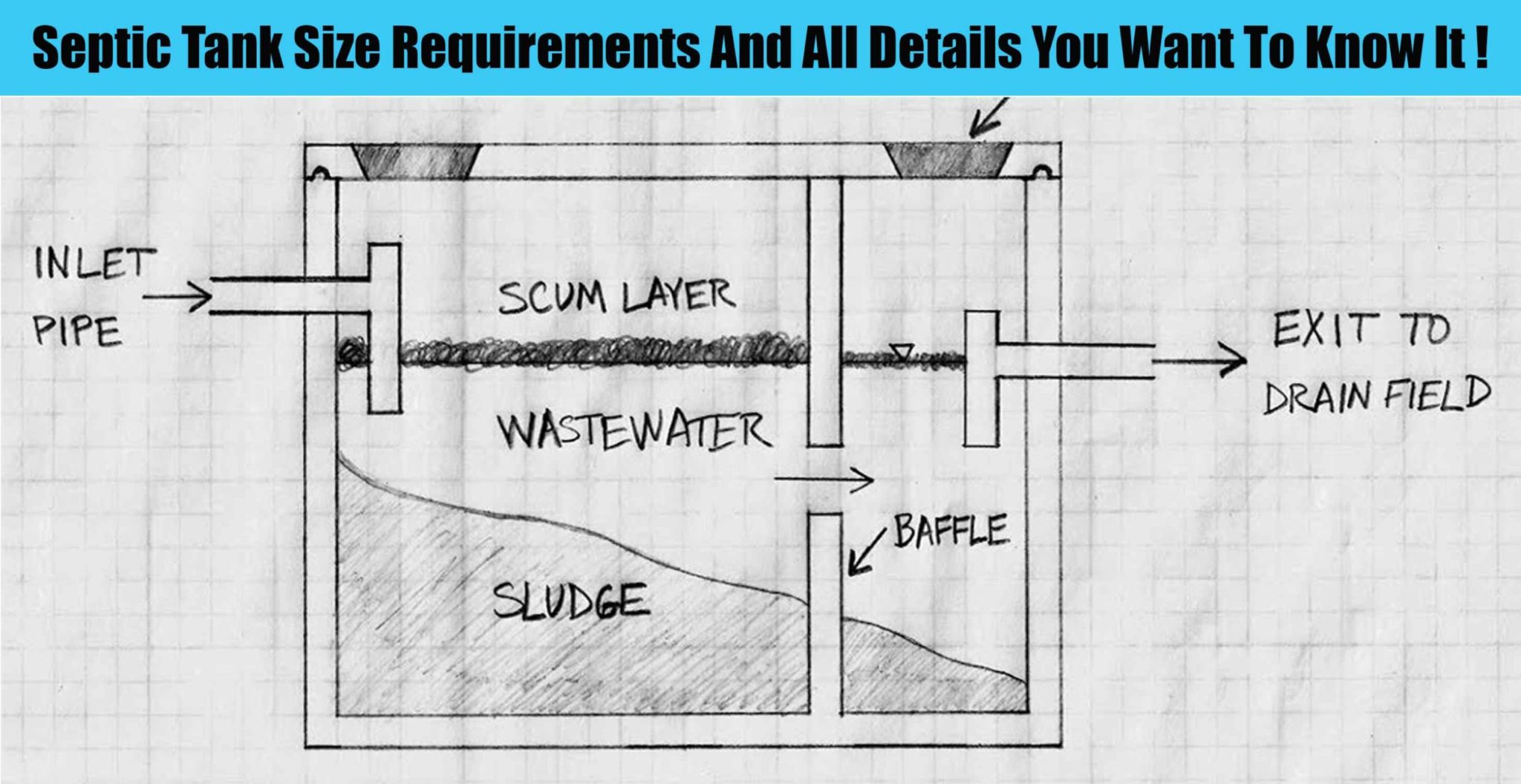

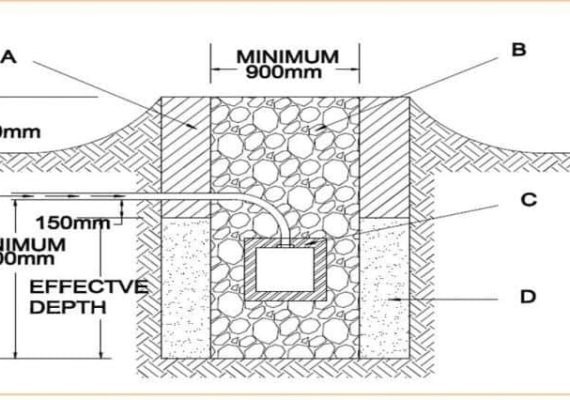
![Advantages of Biodigester + How Biodigester Works [A Simple Guide]](https://www.hpdconsult.com/wp-content/uploads/2019/06/maxresdefault-1-570x400.jpg)
